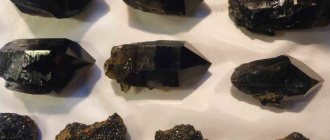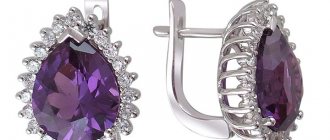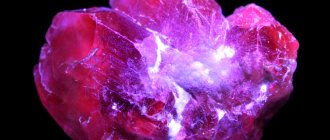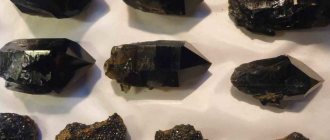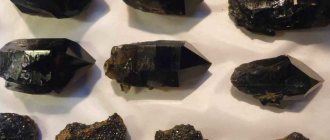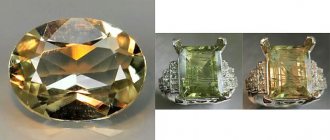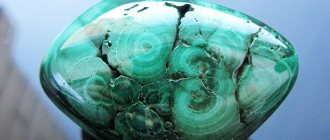In sunlight, the stone takes on a greenish tint; in artificial light, it becomes reddish or purple. Alexandrites from a deposit in the Urals are considered standard: on the world market they are called “Russian”.
Alexandrites are mined only in a few places on the planet, so jewelry-quality samples are highly valued. Fortunately, man has long learned to create precious stones no worse than natural ones. Synthetic alexandrites resemble the best Ural specimens: clean, bright, with a strongly pronounced reverse.
History of synthesis
Alexandrite is a type of the mineral chrysoberyl. The first attempts at its synthesis were made in the second half of the 19th century: the French chemist Jacques Joseph Ebelmain was able to obtain chrysoberyl crystals measuring 5-6 mm in size. He was the first to synthesize a mineral compound that has no analogues in nature, but with the optical properties of alexandrite.
To obtain synthetic chrysoberyl, Ebelman and his students calcined beryllium and aluminum oxides in the presence of mineralizers. The crystals turned out to be small, with numerous flux inclusions. They were not suitable for jewelry purposes.
In the mid-twentieth century, attempts were made in the USA to obtain synthetic alexandrite from a solution in a melt. At first the crystals were small, but by 1964 it was possible to develop a synthesis method suitable for use on an industrial scale. In 1972, the Americans K. Kline and D. Patterson filed a patent for the method of flux from a solution in a lithium molybdate melt.
In 1970, the Japanese company began producing synthetic alexandrites obtained by the Czochralski method - by drawing a crystal from a melt. They were called "kresent-vert" and "inamori". Alexandrites "inamori" had a cat's eye effect - a running glare on the surface.
Currently, alexandrites are synthesized using the zone melting method and the Czochralski method. The resulting crystals are used for both jewelry and technical purposes. Synthetic alexandrites of the best quality are obtained by the Czochralski method.
History of the discovery of the stone
There are two versions of the discovery of alexandrite. According to one of them, the gem was found near Yekaterinburg in 1833, at a river mine. Under the guise of an emerald, the stone was taken to St. Petersburg, where it was classified as a separate type of precious stone.
According to another, it is considered official; the unusual gem was discovered in 1934 by N.G. Nordenskiöld. A Swedish scientist, hired by the Mining Department of Finland, carried out research for emeralds in the Urals, in the area of the famous Emerald Mines. In April 1834, a Swede, while studying another square of the area, accidentally discovered a bright green gem in mica dumps. In the sun it pulsated with the most delicate, green-blue flame. At first, the Swede mistook the stone for an emerald because of its green color, but it differed from the latter in its incredible strength. In the evening, while studying the gem, the scientist brought it to a candle. The stone burst into red flame.
The find was immediately sent to St. Petersburg. Count Lev Perovsky, who served as minister of appanages, began studying the mineral. Due to its unusual ability to change color, the crystal was called “diaphanite”, which is translated from Greek as “double shine”.
Perovsky decided to present the unusual gem to the world on the day of the coming of age of Alexander, the son of Emperor Nicholas II of Russia. Wanting to give a unique gift to the Tsarevich, Perovsky presented the gem to the birthday boy. It received such a beautiful name in honor of Alexander.
In fact, they knew about the stone for a long time. It is mentioned in the treatise "Mahabharata", written several thousand years ago. During excavations, in one of the mounds built in the 12th century, a ring with this gem was found.
So why was it only in the mid-19th century that the general public saw alexandrite jewelry? The answer lies in the superstitions of the Ural miners: the prospector who finds this stone will never see an emerald. That's why they didn't pay attention when the green crystal came across the path.
How to grow alexandrites
To obtain synthetic alexandrites, low-quality natural stones are used. The crushed raw materials are heated and melted. To obtain the desired color, vanadium and chromium oxides are introduced into the melt.
The synthesis process is carried out in a special container, or crucible. It must withstand high temperatures, so it is made of refractory metals - for example, iridium. This platinum group metal costs 3 times more than gold, which affects the final cost of synthetic alexandrites: they cannot be called cheap, although they are cheaper than their natural counterpart.
During the synthesis process, a seed of sapphire or other stone, mounted on a vertical rod, is placed in the melt. Then it gradually rises, rotating and turning, and “pulls” part of the melt behind it. This hardens to form an alexandrite crystal. The cycle is repeated several times until the melt is exhausted.
How to determine the origin of a crystal
In order to find out whether a stone is real or not, it is enough to ask the seller for a certificate confirming its authenticity with the results of a gemological examination. The same document will also indicate the location of the mineral’s extraction.
However, since unscrupulous sellers are increasingly beginning to forge identification documents, the buyer should have in his arsenal several additional ways to detect counterfeits.
You can identify a synthetic crystal based on the following signs:
- size (larger than 3 carats);
- high degree of transparency;
- the shape of the internal bubbles (spherical).
Spinel and corundum do not react to magnets, unlike alexandrite. It shows a weak reaction due to the presence of iron impurities in the composition. In addition, synthetic analogues and the original have different pleochroism.
Important! As for natural stones of a lower class, in most cases it is not possible to identify a fake at home.
Ruby, like sapphire, is rarely used as a replacement for the imperial stone, primarily due to the high cost of the material itself. Garnets and their variety pyrope, just like alexandrite, react to a magnet, but more intensely, and there are no yellow shades in their color palette.
With tourmaline and andalusite everything is simpler. They change color only when the viewing angle changes.
Chemical properties
Alexandrite is not only a beautiful stone, but an extremely hard one. On the Mohs scale its hardness is 8.5. This means that the mineral is practically not scratched, and jewelry with it can be worn every day.
Synthetic alexandrite has the same hardness as natural alexandrite. Its edges do not wear off during wear and remain smooth and neat. And if jewelry with an expensive natural stone may be unsafe to wear every day, then with a synthetic one it is completely safe.
Physical properties of alexandrite
Alexandrite is a gemstone, chrysoberyl. The main physical properties are high hardness, higher than that of emerald, and an impressive ability to change color under artificial light. Jewelers call this metamorphosis color reverse.
The reversal is due to the interaction of two factors at once:
- the presence of trivalent chromium in the composition;
- features in the construction of the crystal lattice.
Chromium ions are able to absorb certain colors, and the crystal lattice refracts certain wavelengths of light.
According to legend, alexandrite has acquired the ability to change color since biblical times. Having witnessed Cain's murder of his brother Abel, the stone drinks Abel's blood every evening and glows red.
On topic: Riddles and secrets of alexandrite
The most common color is bluish-green. Less often – olive, with shades from yellow to brown. Alexandrite, mined in Sri Lanka, can look like a gem from the Urals during the day, but turns purple in the evening.
Because of the mineral’s ability to change color, the writer Peskov very poetically said that the crystal has green mornings and bloody evenings.
Basic physical properties of alexandrite:
- hardness (Mohs scale) - 8–8.5 units;
- density - 3.6–3.8 g/cm3.
As you can see, the gem is second only to diamond in hardness - 10 units. and ruby and sapphire – 9 units. The color is durable and does not fade over time. Alexandrite is resistant to acids, with the exception of hydrofluoric and boric acid. Afraid of alkali. Melts at a temperature of 1855-1880 degrees.
It is unique in its chemical composition: the only gem that does not contain silicon (Si), the most common chemical element on earth (with the exception of oxygen). Its chemical formula BeAl2O4 is a complex oxide of beryllium and aluminum. The mineral contains up to 19.7% beryllium and 80.29% aluminum. In addition, it contains up to 1% iron, 0.3% chromium and often up to 3% titanium. There are, in small amounts, impurities of vanadium, cobalt, nickel and copper.
Comparison of characteristics
When evaluating alexandrite, the color, severity of the reverse, clarity, weight and quality of cut are taken into account. For example, low quality natural stones weighing 3-5 carats
cost on the world market from $600 per carat. Alexandrites of the same mass, but of excellent quality - from 17 thousand dollars per carat and above. Large stones are valued even higher: the record is about 70 thousand dollars per carat.
Synthetic alexandrites are graded for the same characteristics. They cost much less.
Color
In daylight, alexandrite displays a palette of shades ranging from yellow-green to green and bluish-green. Yellowness makes the stone cheaper. The most valuable are alexandrites, which turn green or bluish-green when exposed to natural light.
Under artificial light, the stone takes on a reddish color, sometimes with an orange or purple tint. Red color without additional shades is the most valuable.
Synthetic alexandrites have purer colors than natural ones. This is due to the absence of iron impurities in the crystal. In daylight they look green without a yellow tint, in evening light they look crimson. Some stones also exhibit a cat's eye effect.
The cost of natural alexandrite also depends on how pronounced the color change is. It can be strong, medium or weak. Synthetic alexandrites are characterized by a strong reverse: in this they are comparable to the best Ural specimens.
Purity
Most natural alexandrites have minor inclusions - single points, gas-liquid veils, microcracks. They are not always visible to the naked eye, but they reduce the cost of the stone.
Synthetic alexandrites obtained by the Czochralski method are very pure. They contain almost no inclusions.
Weight
Natural alexandrites are usually small: stones weighing less than 2 carats are common on the world market. Larger specimens are found, but much less frequently.
The Czochralski method makes it possible to grow really large crystals - both for jewelry and for technical purposes. The weight of individual specimens reaches 0.5 kg or more.
Cut shape
For alexandrite, the shape and quality of the cut are important: it should emphasize the color and optical effects inherent in the stone. The most popular options:
- "oval";
- "circle";
- "pear".
Alexandrites with a cat's eye effect, as well as opaque stones, are treated with cabochons.
Natural stones often do not have an ideal cut: in order not to cut off too much material, the cutter deliberately deviates from the standard - for example, skips some of the faces, or changes their angles. This negatively affects the visual perception of alexandrite and reduces its value.
Synthetic stones have a standard cut. The master does not need to save on material, and therefore the proportions are precisely adjusted.
What does the stone look like?
By its origin, alexandrite belongs to one of the types of chrysoberyl, and the unusual color reverse is provided by impurities of chromium, iron and vanadium. High quality stones are transparent and rich in color, but they are extremely rare in nature. Most representatives of this rock are poorly transparent and cloudy.
Be sure to watch: How to distinguish natural turquoise from a fake
The main color of natural stone is green-blue; a little less often you can find minerals of the olive palette with shades from light gold to brown.
During the process of color reversal, the color of the mineral changes from green to dark red and yellow with hints of orange. In rare cases, blue and lilac tones can be observed. It all depends on the purity of the crystal, the main color and the type of lighting.
How to distinguish synthetic alexandrite from natural one
The differences between synthetic and natural alexandrite are noticeable under a microscope. Gemologists focus on the number and nature of inclusions. The easiest to recognize are stones synthesized by the Czochralski method - they are very pure. In addition, synthetic alexandrites exhibit stronger reversal and fluoresce red in ultraviolet.
Cat's eye stones produce a faint fluorescence - orange-red on the inside, and pale yellow on the surface. They are also distinguished using a microscope. Synthetic alexandrites are dominated by fine silty particles, while natural ones are dominated by tubular and needle-shaped inclusions.
Fakes and imitations
Natural alexandrite is a type of chrysoberyl; it differs from other types in its strongly pronounced ability to change color depending on the lighting (from blue-green shades to red-violet).
Due to its high cost, the gem is often counterfeited. To do this, use stones that resemble it in appearance and properties. Artificial alexandrite can be made from synthetic and natural materials.
It is almost impossible to distinguish a natural mineral from a synthetic one with the naked eye. Often the fake is even superior in appearance to the original.
Synthetic fakes
A common replacement option is synthetic alexandrite. It is made from different materials, which affects its properties and appearance.
Corundum
This material began to be used to obtain artificial gems back in Soviet times. With the advent of synthetic alexandrite, its popularity among Soviet citizens increased. The copy was no less attractive, but at the same time its cost was significantly lower, thanks to which many could afford such jewelry.
Artificial stone is able to accurately convey the color characteristics of the prototype and is suitable in terms of hardness. You can distinguish a copy by examining it in the light. An artificial specimen acquires a yellow tint, while a real jewel shimmers with all colors with only a slight predominance of yellow. Now corundum is used less frequently, having been replaced by spinel.
Synthetic spinel
Today, this material is most often used to make artificial gems. But spinel does not quite resemble the prototype in terms of color spectrum: it has absolutely no yellow shades. In the light, spinel changes, and the color is dominated by violet shades; a real stone, when exposed to sunlight, turns green, or less often, red. These noticeable differences make counterfeiting easy to spot. However, people purchase spinel jewelry because of its low cost.
Grown crystals
There is a hydrothermal method for producing artificial gems. The method makes it possible to obtain stones that are almost equal in characteristics to the prototypes. Hydrothermal technology is the crystallization of substances from high-temperature solutions under high pressure. This allows you to create minerals that are difficult or impossible to obtain otherwise.
With the help of technology, we have learned to produce imitations of a large number of precious gems. They have the same chemical and physical structure, have the same characteristics and optical properties as the originals. Rocks grown hydrothermally are even believed to have the same magical and healing properties as natural ones. Therefore, it would not be entirely correct to classify them as fakes; they are a good substitute for expensive gems.
Imitation with natural stones
Often, alexandrite can be replaced by imitation using other natural minerals. Such a fake can be very difficult to identify, since at first glance the samples may not be different. Stones similar to alexandrite are not inferior to it in appearance and main characteristics, but are inferior in rarity. These include:
- Tourmaline. There are varieties that differ little from natural alexandrite. For example, watermelon tourmaline, shimmering red and green. But the color change does not depend on the lighting, but on the change in viewing angle.
- Ruby. It is similar in color and hardness to alexandrite; it is unlikely that you will be able to distinguish them on your own.
- Zircon . The least quality replacement for a gem. Upon careful inspection, any buyer who is familiar with the main characteristic of the prototype - the color reverse - will notice the substitution.
- Pomegranate. Garnet varieties containing chromium resemble alexandrite, but lack the blue and purple tones.
- Andalusite. Even a jeweler will not be able to immediately distinguish green andalusite from the imperial stone; it is also very beautiful, and the color range is even wider. This is also a rare mineral, which makes its use for imitation not very practical. Andalusite is cheaper.
Glass and alexandrite
Glass is a cheap and easy way to counterfeit jewelry. This option has been used for a long time in the manufacture of various crystals. To do this, chromium is added to the raw material, which gives the samples a characteristic shine and all kinds of colors.
Glass has significantly lower strength values compared to previous synthetic materials used to make artificial alexandrite. In addition, glass is subject to mechanical damage, chips form on it, and scratches easily appear.
You can identify falsification by observing the shimmer of the decoration in natural light: the glass will not shimmer much and change shades.
How to distinguish synthetic alexandrite from imitation
There is a myth that in Soviet times a huge amount of jewelry with alexandrites was sold. Ural precious stones were used as inserts, and they cost mere pennies. Unfortunately, this is not so: the stones were not natural, not from the Urals, and not alexandrites.
In jewelry, several imitations with a color changing effect are used:
- synthetic corundums;
- synthetic spinel;
- doublets;
- cubic zirconias;
- nanotals.
Synthetic corundum is the most successful imitation. A crystal colored with vanadium turns pale green in daylight, and pink in artificial light. It can be recognized by its color palette, inclusions in the form of bubbles, as well as a narrow, clear line in the blue region of the spectrum.
Synthetic spinel was used to imitate alexandrites in the USSR. It is distinguished using a refractometer. Spinel is characterized by the absence of birefringence, a significantly lower refractive index, and a less diverse and plausible range.
Doublets are made from garnet and glass. The garnet top imitates the redness of alexandrite, while the glass top imitates the green. They differ from the original in hardness and other physical properties, and are also inferior in gloss.
Cubic zirconia has almost twice the density of alexandrite. In synthetic crystals, inclusions and growth lines will be noticeable under a microscope, but not in artificial cubic zirconia and nanotals.
What to consider when buying a gem
The first thing you should pay attention to when purchasing products with alexandrite is the size of the stone. Large, richly colored gems at a very reasonable price will 100% turn out to be fake. A weight of 2-4 carats is the maximum size that modern jewelry brands can offer and such products will cost from several thousand to several tens of thousands of dollars, depending on the purity and natural color of the mineral. The price of even the simplest grayish-colored gems starts from $300-350.
10607_10606.psd
It doesn't hurt to know what natural alexandrite looks like. Saturated bright color is practically not characteristic of it. Bright green, reddish and purple gems are most likely to be imitation or synthetic. The original has a calm color and moderate transparency.
If there are air bubbles in the crystal, their shape should resemble a drop. Bubbles-spheres are a sign of a synthetic mineral.
Important! Most jewelry made in the 19th century has natural alexandrite inlays. However, before purchasing, it is still recommended to conduct a spectral analysis of the stones.
Is synthetic alexandrite better or worse than the original?
The main advantage of synthetic alexandrite over natural alexandrite is price. Although due to the high cost of production it cannot be called completely cheap, it is still much cheaper than the original. Visually, the stone is indistinguishable: to see the differences, you need a microscope.
Alexandrite synthesized by the Czochralski method has pure and bright colors. It exhibits a strong reversal: it turns from red to green when the lighting changes, and vice versa. Natural stones with such a pronounced color change effect are rare.
Synthetic alexandrite is practical. If you love this amazing stone, you can wear jewelry with it every day without worrying too much about possible loss. Jewelry with natural alexandrites, which cost fabulous amounts of money, will most likely remain in the box most of the time.
Alexandrite and profession
Since the stone has strong energy, calm, balanced individuals are not recommended to wear it - in such a situation it has a destructive effect on the psyche, suppressing positive emotions. Housewives, factory and factory workers are unsuitable professions for alexandrite.
This stone is a powerful talisman of strong people in positions of power: directors, businessmen, organizers, political leaders and athletes. The stone will give such people tolerance and perseverance, which will help them achieve their goals.
Alexandrite also has a positive effect on people of creative professions: artists, singers, writers and performers. It allows you to more calmly experience failures and tune in to work, and look more objectively at the results of your work.
The properties of alexandrite to suppress passions and excitement are valued by clergy and highly spiritual individuals, since this stone helps to tune in to meditation and prayer.
When thinking about whether to buy alexandrite, you should not be guided by the belief about the widow’s stone - this is a reservation. Once you buy alexandrite, you will not want to part with it - it is so mesmerizing.
Combination with other stones
If, when wearing a stone, there is no change for the better in a person’s life and state of mind, it means that it is being used incorrectly. There are several important laws on how to wear a talisman correctly.
When using it, it is important to research which stones alexandrite can be worn with. It goes perfectly with gold, emerald, garnet, ruby and diamond.
Each natural mineral creates a magical field around itself. When combining energetic energies of different natures, a person may experience discomfort.
It is recommended to wear the talisman on your finger, enclosed in a ring or ring. You shouldn’t take someone else’s jewelry or put your own on someone else. According to ancient belief, fate is passed on from one person to another in this way, but it is not always happy.
The difference between artificial crystals
Artificial alexandrites are slightly different in color from natural ones, because it is difficult to achieve absolute similarity with what nature created.
Synthetic analogues have the following color palette:
- from blue-green to purple-crimson (such shades appear in stones grown using the Czochralski method);
- from green with yellow highlights to purple-red (these characteristics are possessed by alexandrite grown by the flux method - from a solution with lithium molybdate);
- from bluish-violet to red-pink (characteristic colors for minerals, with an admixture of vanadium, they were often found on the jewelry market of the Soviet period);
- from various shades of green to yellow.
You can study in detail what shade a natural precious mineral is by reading the article “The color of the alexandrite stone.”
In addition to color, laboratory minerals are distinguished from natural ones by the severity of the trichroism effect. The former, like natural ones, have the ability to change the color palette. It’s just that the number of shades of synthetic alexandrite is slightly larger and, accordingly, the color reverse is wider.
It is worth mentioning that the mineral is popular not only in jewelry. Thanks to its optical and physical properties, it is useful as an engineering material. It is used in quantum electronics, medicine and the processing of solid materials. Also in the field of medical cosmetology and eye microsurgery, the use of a laser with an artificial crystal is gaining popularity.
Why is the stone worn in pairs and can it be worn in marriage?
This gem is the most controversial talisman that can attract both good luck and bad luck. Wearing alexandrite in pairs is recommended for a reason. This is not a marketing ploy for jewelry stores. The crystal will bring energetic balance to life if worn only as a pair or in a set of jewelry. Without a partner, it is ineffective, and sometimes even harmful, disrupting harmony.
It is not recommended to wear alexandrite to married women. Since ancient times, jewelry has been given the status of “widow’s stone,” leading to separation and family unhappiness. This is due to a number of events.
During the Great Patriotic War, spouses gave their wives jewelry with this mineral before leaving for the front. Most of them did not return home. It is not without reason that only Russian women have a negative opinion about the crystal. Representatives of other countries consider it a talisman of happiness and love, also assuring that it should be worn in pairs to attract good luck. Read more in the article “Widow's Stone: Why Alexandrite is Called the Stone of Loneliness.”
By the way, it is believed that this talisman is necessary for divorced people. They need to collect their thoughts and find the strength to move on. It is these qualities that alexandrite can bestow.
The difference between alexandrite and other gems
To distinguish another gemstone from alexandrite, you need to pay attention to the following:
- The crystal has a pronounced ability to change color under different lighting, while other minerals have a constant, characteristic color for them.
- It can be distinguished from amethyst by its predominantly purple hues and lower hardness.
- The color change of tourmaline does not depend on lighting, but on the viewing angle.
- Ruby differs from alexandrite by the predominance of the red spectrum and a higher hardness.
- When compared with sapphire, a real imperial stone can be distinguished by its characteristic rich blue color.
- There are no blue or purple tones in garnet.
- Zircon has low hardness and color reversal.
Thus, it is possible to distinguish a natural gem from its imitations. But it’s worth considering that the difficulty of identifying a fake depends on the material and method of manufacturing the artificial stone.
What was sold in the Union under the guise of natural crystals
From the 30s to the 70s of the last century, a large number of products with minerals of supposedly natural origin were sold on the USSR jewelry market. But in fact it was synthetic corundum, just with an alexandrite effect.
Synthetic stones from the times of the USSR have the following characteristics:
- light lilac crystals with good transparency and minimal color change;
- dark burgundy, ruby-like alexandrite, it was most often found during the 80s and 90s of the last century;
- gray-olive elements, this is a rather rare version of alexandrite - a low-grade synthetic stone.
The artificial mineral, which was of great importance in the trade turnover of that period, was very similar in color reverse to the natural one. The only difference was the presence of yellowish tints specific to alexandrite. In daylight, synthetic jewelry corundum has this shimmer. In the evening, its color may even turn into a dirty brown.
Natural alexandrite can turn yellow, but only under special filters. In this case, the crystal always has greenish highlights of different shades.
Nowadays, synthetic corundums with an alexandrite effect are found mainly in jewelry from the Soviet period. The production of such minerals has already ceased.
The difference between natural stone and synthetic stone
The difference between an artificial mineral and a real one is that the latter is a creation of nature; it has been formed over the years. The first one was grown in the laboratory. Its chemical, physical and optical properties are similar to natural stone, but do not replicate them. Real alexandrite is almost the same mineral, but formed not in natural conditions, but in a “chemical kitchen”.
Imitation crystals are a product that only externally looks like minerals that were made by nature. At the same time, the fake has nothing in common in terms of chemical and optical properties. For more information about the properties of a real crystal and whether it can provide real benefits, read the article “Alexandrite: properties of the stone and who it suits according to their zodiac sign.”
Alexandrite is a stone that is often found in artificial form on the jewelry market. It is available in white gold or platinum.


